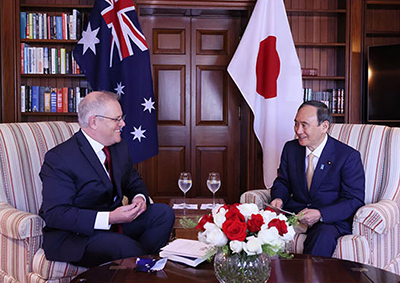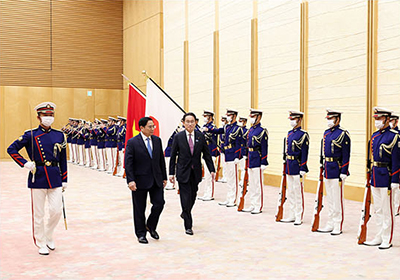Diplomatic Bluebook 2022
Chapter 2
Japan's Foreign Policy by Region
Section 2 Asia and Oceania
1 Overview
(General overview)
The Asia-Oceania region includes not only the second and third largest economies in the world, China and Japan, but also numerous emerging countries with remarkable growth. It is a dynamic region where diverse cultures and races intermingle and influence each other. This region, with an abundance of human resources, drives the world economy and has been increasing its presence. Of the world population of 7.9 billion, approximately 2.3 billion people live in the signatory States of the Regional Comprehensive Economic Partnership (RCEP) Agreement.1 This represents about 29% of the world's population.2 Their combined nominal gross domestic product (GDP) has increased by more than 130% over the last 10 years, and accounts for about 30% of the world total.3 In addition, their total imports and exports are 9.8698 trillion US dollars (2020), which is comparable to the EU's imports and exports of 10.4448 trillion US dollars.4 There are close economic ties among these nations, and they have a high degree of interdependence. Further economic growth is expected, and this strong growth within the region will also help to bring renewed affluence and vitality to Japan.
Meanwhile, the security environment in the Asia-Oceania region is becoming increasingly severe as seen in the following developments: the nuclear and missile development by North Korea; the strengthening and modernization of military forces in a manner that lacks transparency and attempts to change the status quo in the region by force that goes against the rule of law and openness; and tension within the region growing over the maritime issues. Other factors hindering the stable growth of the region include economic and financial systems still under development, environmental pollution, unstable demand and supply of food and resources, frequent natural disasters, and aging population.
Against this backdrop, Japan has been actively engaging in diplomacy including at the leaders' and foreign ministers' levels. In 2021, continuing on from 2020, due to the impacts of the novel coronavirus disease (COVID-19), visits to other countries were severely restricted, but, even under such circumstances, the prime minister and foreign minister of Japan, in addition to face-to-face diplomacy, actively held telephone calls and teleconferences to maintain and develop good relations with neighboring countries. Prime Minister Suga held bilateral telephone calls with ASEAN countries and Australia, etc., and in March he attended the Japan-Australia-India-U.S. Leaders' Video Conference, the first such meeting at the leader level. In July, the Ninth Pacific Islands Leaders Meeting (PALM9) was held via teleconference, and, together with this, Prime Minister Suga held bilateral leaders' meetings with Pacific Island countries via teleconferences. Additionally, when he attended the Japan-Australia-India-U.S. Summit Meeting held in the U.S. in September, Prime Minister Suga met with Australian Prime Minister Morrison and Indian Prime Minister Modi. Since assuming the office of Prime Minister in October, Prime Minister Kishida has had telephone calls with Australia, China, the Republic of Korea (ROK), India, and many other Asian and Oceanian countries. In addition, Prime Minister Kishida attended ASEAN-related Summit Meetings that were held via teleconference at the end of October. Through these three forums (ASEAN-Japan Summit Meeting, ASEAN Plus Three (JAPAN-China-ROK) Meeting, and East Asia Summit (EAS) (all held on October 27)), Prime Minister Kishida confirmed that respecting ASEAN centrality and unity, Japan had been advancing concrete cooperation in line with the priority areas of maritime cooperation, connectivity, SDGs and economy, with the November 2020 “Joint Statement of the 23rd ASEAN-Japan Summit on Cooperation on ASEAN Outlook on the Indo-Pacific (AOIP)”5 as a guideline. Prime Minister Kishida also sent strong messages about the situations in North Korea, the East China Sea and South China Sea, and Myanmar. Furthermore, Prime Minister Kishida held a meeting with Prime Minister Chinh of Viet Nam upon his visit to Japan in November, and the two leaders issued a joint statement. Foreign Minister Motegi took the opportunity to attend the G7 Foreign Ministers' Meeting held in the UK in May, participated in the Japan-U.S.-ROK Foreign Ministers' Meeting, and met with Australian Minister for Foreign Affairs Payne, ROK Minister of Foreign Affairs Chung Eui-yong, and Indian External Affairs Minister Jaishankar. In August, Foreign Minister Motegi actively contributed to the discussions at ASEAN-related Foreign Minister's Meetings, at the Friends of the Mekong6 Ministerial Meeting, and at the Mekong-Japan Foreign Ministers' Meeting, which were held via teleconference. In September, Foreign Minister Motegi visited the U.S. to attend the United Nations General Assembly and participated in the Japan-U.S.-ROK Foreign Ministers' Meeting. After the inauguration of the new Cabinet in November, Foreign Minister Hayashi actively met with and exchanged opinions with Australia, China, India and Mongolia. Foreign Minister Hayashi held bilateral telephone calls with ASEAN countries (Indonesia, Cambodia, Singapore, Thailand, Philippines, Brunei, Malaysia and Laos), and in November had a face-to-face meeting with Foreign Minister Son of Viet Nam. In December, when he visited the UK to attend the G7 Foreign and Development Ministers' Meeting, Foreign Minister Hayashi held a meeting with Australian Foreign Minister Payne.
Japan is strengthening various cooperation in the Asia-Oceania region and will continue to make meaningful use of various cooperative frameworks.
 Japan-Australia Summit Meeting (September 24, Washington D.C.; Photo: Cabinet Public Relations Office)
Japan-Australia Summit Meeting (September 24, Washington D.C.; Photo: Cabinet Public Relations Office) Escort and salute by honor guard upon the arrival in Japan of Prime Minister Chinh of Viet Nam (November 24, Prime Minister's Office; Photo: Cabinet Public Relations Office)
Escort and salute by honor guard upon the arrival in Japan of Prime Minister Chinh of Viet Nam (November 24, Prime Minister's Office; Photo: Cabinet Public Relations Office)- 1 RCEP Agreement signatory States: the 10 ASEAN member states (Brunei Darussalam, Cambodia, Indonesia, Lao Republic, Malaysia, the Union of Myanmar, Philippines, the Republic of Singapore, the Kingdom of Thailand, and Viet Nam), Australia, China, Japan, the ROK and New Zealand, for a total of 15 countries
- 2 United Nations Population Fund, “Annual Report 2021”
- 3 World Bank (WB)
- 4 International Monetary Fund (IMF)
- 5 Adopted at the ASEAN Summit Meeting in June 2019. It is based on the principles of strengthening ASEAN Centrality in the Indo-Pacific region, as well as openness, transparency, inclusivity, a rules-based framework, good governance, respect for sovereignty, non-intervention, complementarity with existing cooperation frameworks, equality, mutual respect, mutual trust, mutual benefit, and respect for international law, such as the UN Charter, the UN Convention on the Law of the Sea and other relevant UN treaties and conventions. Based on this, it promotes cooperation in the areas of maritime cooperation, connectivity, the SDGs, and economic and other possible areas.
- 6 Friends of Mekong: Formerly “Friends of the Lower Mekong (FLM)”
A U.S.-led framework aimed at promoting coordination and cooperation among development partners engaged in cooperation with the Mekong. Then-Foreign Minister Kishida from Japan attended the Ministerial Meeting that was held in Myanmar in 2014.
(Japan-U.S. Alliance and Indo-Pacific region)
The Japan-U.S. Security Alliance, with the Japan-U.S. Security Arrangements as its core, is the foundation of peace, security, and prosperity, not only for Japan but also for the Indo-Pacific region. In the midst of an increasingly severe regional security environment, the Japan-U.S. Alliance is more important than ever. Since the inauguration of President Biden in January 2021 and until the end of February 2022, 8 Summit Meetings and 15 Foreign Ministers' Meetings have been held, including telephone calls. The two countries have been working closely at multiple levels, including at the summit level and at the foreign minister level, to address the various issues of the Indo-Pacific region, including those related to North Korea.
Furthermore, Japan and the U.S., are deepening their cooperation in achieving a “Free and Open Indo-Pacific (FOIP),” even amidst the spread of COVID-19. In March, just two months after the inauguration of the Biden administration, Secretary of State Blinken and Secretary of Defense Austin visited Japan as the first overseas trip by Biden administration secretaries, and the Japan-U.S. Security Consultative Committee (Japan-U.S. “2+2”) was held with Foreign Minister Motegi and Defense Minister Kishi. The four Ministers reaffirmed that the Japan-U.S. Alliance remains the cornerstone of peace, security, and prosperity in the Indo-Pacific region, and renewed the unwavering commitment of both countries to the Japan-U.S. Alliance. Additionally, Prime Minister Suga visited the U.S. in April and held a Japan-U.S. Summit Meeting with U.S. President Biden, and they issued a joint statement confirming that Japan and the U.S. will strengthen their unity and cooperation while partnering with like-minded countries such as Australia, India, and ASEAN countries toward the realization of a FOIP. In October, Prime Minister Kishida, on the day after assuming the office of Prime Minister, held a Japan-U.S. Summit telephone call with President Biden, and the two leaders agreed to further peace and stability in the region and in the international community through realizing a FOIP. Furthermore, in November, Foreign Minister Hayashi held a Japan-U.S. Foreign Ministers' telephone call with Secretary of State Blinken, and the two Ministers confirmed that Japan and the U.S. will work closely in realizing a FOIP. In January 2022, a Japan-U.S. “2+2” was held via teleconference for the first time, with Foreign Minister Hayashi and Defense Minister Kishi participating from the Japanese side and Secretary of State Blinken and Defense Secretary Austin participating from the U.S. side. The Ministers had frank and important discussions on how to evolve the Japan-U.S. Alliance and on effectively addressing current and future challenges, and confirmed the commitment to a FOIP. In January, Prime Minister Kishida held a Japan-U.S. Summit Video Teleconference Meeting with President Biden. The two leaders shared their intention to coordinate closely under the strong Japan-U.S. Alliance and to deepen cooperation with like-minded countries such as Australia, India, ASEAN, and Europe, toward realizing a FOIP.
(Japan's measures on the comfort women issue)
(See 3(2)A(C) regarding the comfort women issue between Japan and the ROK.)
The Government of Japan has sincerely dealt with the issues of reparations, property and claims pertaining to the World War II, including the comfort women issue, under the San Francisco Peace Treaty, which the Government of Japan concluded with 45 countries, including the U.S., the UK and France, and through other bilateral treaties, agreements and instruments. These issues including those of claims of individuals have already been legally settled with the parties to these treaties, agreements and instruments.
On this basis, the Government of Japan has actively taken measures to recover the honor of former comfort women and to provide remedies for them. In 1995, the Asian Women's Fund (AWF) was established with the cooperation of the people and the Government of Japan for the purpose of carrying out atonement and remedy projects for former comfort women. The Government of Japan provided a total of 4.8 billion Japanese yen. In addition, approximately 600 million Japanese yen was donated to the AWF by the people of Japan. The Government of Japan extended maximum cooperation to the AWF, which implemented medical and welfare support projects and provided “atonement money,” to offer realistic relief to former comfort women. As part of the AWF's projects, “atonement money” (2 million Japanese yen per person), which was funded by donations from Japanese people, was provided to 285 former comfort women (211 in the Philippines, 61 in the ROK, 13 in Taiwan). Moreover, the AWF provided funds in those countries/areas for medical and welfare support funded with contributions by the Government of Japan (3 million Japanese yen per person in the ROK and Taiwan, 1.2 million Japanese yen per person in the Philippines) (for a total of 5 million Japanese yen per person in the ROK and Taiwan, 3.2 million Japanese yen per person in the Philippines). Furthermore, using funds contributed by the Government of Japan, the AWF extended support for projects to promote social welfare services for elderly people in Indonesia as well as projects to help improve the living conditions of former comfort women in the Netherlands.
When the “atonement money” as well as the medical and welfare support were provided to individual former comfort women, then-Prime Ministers (namely, Prime Ministers Hashimoto Ryutaro, Obuchi Keizo, Mori Yoshiro and Koizumi Junichiro) sent signed letters expressing their apology and remorse directly to each former comfort woman.
As stated in the Statement by the Prime Minister issued in 2015, Japan will engrave in its heart the past, when the dignity and honor of many women were severely injured during wars in the 20th century. Japan will lead the world in making the 21st century an era in which women's human rights are not infringed upon.
Despite such sincere efforts by the Government of Japan, there are claims that can hardly be regarded to be based on historical facts, such as allegations of “forceful taking away” of comfort women and “sex slaves” as well as the figures such as “200,000 persons” or “several hundred thousands” for the total number of comfort women.
The Government of Japan's position regarding these claims is as follows:
“Forceful taking away”
“Forceful taking away” of comfort women by the Japanese military and government authorities could not be confirmed in any of the documents that the Government of Japan was able to identify.
“Sex slaves”
The expression of “sex slaves” contradicts the facts and should not be used. This point was confirmed with the ROK on the occasion of the Japan-ROK Agreement in December 2015 and the expression “sex slaves” is not used in the agreement.
Figures such as “200,000 persons” for the total number of comfort women
The figure “200,000 persons” lacks concrete evidence. As stated in the report of the Government study's result of August 4, 1993, it is virtually impossible to determine the total number of comfort women as no documents have been found which either indicate the total number or give sufficient ground to establish an estimate.
The Government of Japan has been making efforts to provide clear explanations regarding its sincere efforts and official position in international fora. Specifically, at the United Nations (UN), the Government of Japan has explained its position on a number of occasions such as during the consideration of the Seventh and Eighth Periodic Reports by the Government of Japan on the implementation of the Convention on the Elimination of All Forms of Discrimination against Women (CEDAW) in February 2016, and the Ninth Periodic Report on the Implementation of the CEDAW in September 2021.
Installations of comfort woman statues7 have been observed not only in the ROK but also in the U.S., Canada, Australia, China, Germany, the Philippines, Hong Kong and Taiwan. Such moves are extremely regrettable and incompatible with the position of the Government of Japan. In February 2017, the Government of Japan submitted its amicus curiae brief to the U.S. Supreme Court for the trial concerning a comfort woman statue installed in Glendale in the suburbs of Los Angeles, U.S. The Government of Japan will continue reaching out to various people involved in this issue to explain its position.
The below Ministry of Foreign Affairs website details Japan's Efforts on the Issue of Comfort Women.
https://www.mofa.go.jp/policy/postwar/page22e_000883.html

- 7 For the sake of practical convenience, they are referred to as “comfort woman statues.” However, the use of this term is not a reflection of the recognition that these statues correctly embody the reality of those women at that time.
